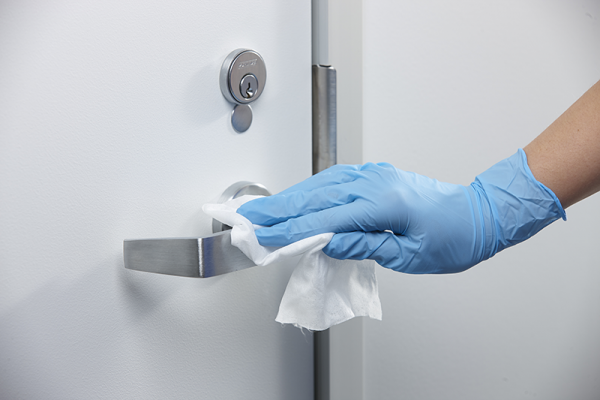CloroxPro Blog – Professional Cleaning and Disinfection Insights
A blog from industry experts devoted to public health awareness, best practices, and the role of environmental cleaning and disinfection, to promote safer, healthier public spaces.
Plan to Prevent https://www.cloroxpro.ca/blog/plan-to-prevent/ May 25, 2020 August 18, 2020 https://www.cloroxpro.ca/wp-content/uploads/2020/07/Plan-to-prevent-1.pngPlan to Prevent
Process compliance for optimal protection against healthcare-associated infections
Maintaining a safe, clean and hygienic environment, and minimizing microbial contamination of surfaces, items and equipment within the healthcare environment are increasingly recognized as an essential approach to reducing the risk of healthcare-associated infections.1,2
Pathogens can spread easily in high-traffic facilities. Cleaning and disinfection of equipment (medical, clinical) are important components of preventing the spread of microorganisms that can cause infections; however, such equipment is often composed of many different materials, each of which may respond differently to disinfectants used in healthcare and fitness facilities.3
Pathogens such as Clostridium difficile, vancomycin-resistant enterococci (VRE) or methicillin-resistant Staphylococcus aureus (MRSA)can persist on surfaces and items for prolonged periods of time, sometimes up to several months.4
Healthcare providers who come in contact with surfaces in the room of a patient colonized with MRSA or VRE have a 42% to 52% risk of subsequent hand or glove contamination with the same organism; this risk is similar to the risk seen following direct contact with the patient.5,6 After contact with a VRE-contaminated surface, healthcare providers transmit VRE to the next clean surface or skin site they come in contact with approximately 10% of the time.7
Studies show that up to 85% of wheelchairs in hospitals are contaminated with pathogens such as MRSA.8
A newly released Canadian report suggests that antibiotic resistance is expected to have a stark impact over the next three decades, with superbugs estimated to lead to 400,000 deaths, resulting in $120 billion in hospital costs by 2050.9
Optimize your disinfection strategy
The cornerstone of efforts to reduce the risk of transmission of microorganisms from the environment is the cleaning and disinfection of all surfaces, items and equipment in the healthcare setting on a regular and systematic basis.10

In its recent report, Best Practices for Environmental Cleaning for Prevention and Control of Infections in All Health Care Settings, the Provincial Infectious Diseases Advisory Committee l (PIDAC) suggests the following should be considerations when deciding upon an effective cleaning and disinfection strategy:11
- Frequency of cleaning
- Cleaning method
- Types of cleaning solutions
- Kill claims
- Contact and drying times of cleaning solutions
- Surface compatibility
- Alcohol-free
- Odour
- Ease of use and aesthetics
- Cost and environmental impact
Know your high-risk surfaces
High-touch surfaces and items require more frequent cleaning and disinfection than low-touch surfaces and items, for example, patient beds and surrounding equipment, light switches, blood pressure and ECG carts, nursing stations, call bells, door handles, washrooms, etc.11
Additionally, to prevent the transfer of pathogens from the previous room occupant to a new patient, the room or bed space must be cleaned and disinfected thoroughly.11
Only about 50% of surfaces in hospital operating or patient rooms are effectively disinfected.12
CloroxPro™ can help
Clorox Professional is continually developing advanced and comprehensive solutions that help eliminate healthcare-associated infections wherever they are.
Get in touch.
To get more information either email us, or click on the contact us tab for more options.
References:
- Dancer SJ. Eur J Clin Microbiol Infect Dis 2011;30(12):1473-81. https://www.ncbi.nlm.nih.gov/pubmed/21499954
- Weber DJ, Rutala WA. Infect Control Hosp Epidemiol 2013;34(5):449-52. https://www.ncbi.nlm.nih.gov/pubmed/23571359
- Lankford MG, et al. Limiting the spread of infection in the health care environment. Assessment of materials commonly utilized in healthcare: Implications for bacterial survival and transmission. Concord, CA: Coalition for Health Environments Research (CHER) and The Center for Health Design; 2007. http://www.healthdesign.org/sites/default/files/limiting_the_spread_of_infection.pdf. Accessed November 20, 2019.
- Kramer A, et al. BMC Infect Dis 2006;6:130. https://bmcinfectdis.biomedcentral.com/articles/10.1186/1471-2334-6-130 Accessed November 20, 2019.
- Hayden MK, et al. Infect Control Hosp Epidemiol 2008;29(2):149-54. https://www.ncbi.nlm.nih.gov/pubmed/18179370
- Boyce JM, et al. Infect Control Hosp Epidemiol 1997;18(9):622-7. https://www.ncbi.nlm.nih.gov/pubmed/18636950
- Duckro AN, et al. Arch Intern Med 2005;165(3):302-7. https://www.ncbi.nlm.nih.gov/pubmed/15710793
- Hakuno H, et al. J Hosp Admin 2013;2(2):55-60. http://www.sciedu.ca/journal/index.php/jha/article/view/2081/1222
- Council of Canadian Academies, 2019. When antibiotics fail. Ottawa (ON): The Expert Panel on the Potential Socio-Economic Impacts of Antimicrobial Resistance in Canada, Council of Canadian Academies. https://cca-reports.ca/wp-content/uploads/2018/10/When-Antibiotics-Fail-1.pdf
- Donskey CJ. Am J Infect Control 2013;41(5 Suppl):S12-9. https://www.ajicjournal.org/article/S0196-6553(13)00055-2/fulltext
- Ontario Agency for Health Protection and Promotion (Public Health Ontario), Provincial Infectious Diseases Advisory Committee. Best practices for environmental cleaning for prevention and control of infections in all health care settings, 3rd edition. Toronto, ON: Queen’s Printer for Ontario; 2018. https://www.publichealthontario.ca/-/media/documents/bp-environmental-cleaning.pdf
- Bhalla A, et al. Infect Control Hosp Epidemiol 2004;25(2):164-7. https://www.cambridge.org/core/journals/infection-control-and-hospital-epidemiology/article/acquisition-of-nosocomial-pathogens-on-hands-after-contact-with-environmental-surfaces-near-hospitalized-patients/769D83D7E339926251D4B9F145E99F72
